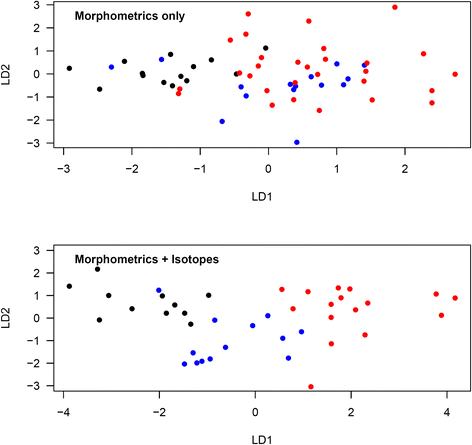Morphometrics and stable isotopes differentiate wintering populations of a migratory bird
- PMID: 27486515
- PMCID: PMC4970205
- DOI: 10.1186/s40462-016-0085-6
Morphometrics and stable isotopes differentiate wintering populations of a migratory bird
Abstract
Background: Describing migratory connectivity in mobile animals is crucial for understanding the selective pressures acting on different populations throughout their life cycle. Tracking single individuals has provided valuable data, but for most species the data available are still spurious and usually limited to a few individuals. Since different populations of migratory birds can be distinguished by a combination of morphometric measurements and the isotopic composition of their feathers, it is possible to measure these parameters on a large sample to differentiate populations.
Methods: We studied northern wheatears, Oenanthe oenanthe, captured in their African wintering range and applied discriminant analyses on morphometric measurements and stable isotope signatures to determine whether birds found in different areas were distinguishable from each other.
Results: Morphometric and isotopic measurements alone were not sufficient to discriminate between the birds of ssp. oenanthe from different areas in Africa. When combining the two measurements, however, assignment to the different groups became substantially more accurate. Following the discriminant analysis of morphometrics and δ(2)H, δ(13)C, and δ(15)N isotopes signatures, 19 of 20 oenanthe from Kenya, 15 of 20 oenanthe from Mali/Mauritania, and 19 of 20 oenanthe from Niger were assigned correctly to their wintering area.
Conclusions: Our results show that birds at different wintering sites can be distinguished from each other when using a combination of markers. We discuss the possible breeding origins of these wintering birds.
Keywords: Connectivity; East Africa; Oenanthe oenanthe; Sahel; Wintering.
Figures



References
-
- Peach W, Baillie S, Underhill L. Survival of British Sedge Warblers Acrocephalus schoenobaenus in relation to west African rainfall. Ibis. 1991;133:300–5. doi: 10.1111/j.1474-919X.1991.tb04573.x. - DOI
-
- Ebbinge BS, Spaans B. The importance of body reserves accumulated in spring staging areas in the temperate zone for breeding in dark-bellied brent geese Branta bernicla bernicla in the high arctic. J Avian Biol. 1995;26:105–13. doi: 10.2307/3677058. - DOI
-
- Bairlein F, Henneberg H. Der Weißstorch (Ciconia ciconia) im Oldenburger Land. Isensee: Oldenburg (Germany); 2000.
LinkOut - more resources
Full Text Sources
Other Literature Sources

